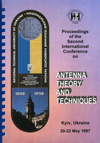Experimental investigations of directional and polarization characteristics of reflector antenna feeds
DOI:
https://doi.org/10.1109/ICATT.1997.1235154Abstract
It is known from antenna theory and practice that directional gain, aperture area using ratio, and side lobe level of reflector antennas depend on the amplitude distribution of the field sources at the radiating aperture. The most acceptable is the U-shape of the amplitude distribution of the field sources. Besides, it is desirable that the primary feed pattern has an axis of symmetry. Several feeds types are known providing such characteristics and having simple construction and wide bandwidth: pyramidal horn with a diagonal excitation [1], flare-angle changed conical and pyramidal horns [2], flare-angle changed pyramidal horn with a diagonal excitation [3], the open end of a circular waveguide with impedance flange [4]. By now a great attention is paid to investigating polarization characteristics of such feeds.
In this article the comparison of experimental results of the directional and polarization characteristics of the above-mentioned radiators was carried out.
References
Love, A.W. Diagonal Horn Antenna. Microwave Journal, 1962, Vol. 3, No. 3, p. 117-122.
Cohn, S. Flare-Angle Changes in a Horn as a Mean of Pattern Control. Microwave Journal, 1970, Vol. 13, No. 10, p. 41-46.
Gorobets, N.N.; Dakhov, V.M.; Snopic, L.M. Directional and Cross-polarizational Characteristics of Pyramid Horn with Diagonal Excitation by the Principal Mode. Proc. of 5th Crimear Conf. and Exhibition on Microwave and Satellite Telecommunications Technology, 25-27 Sept., 1995, Sevastopol, Ukraine. 1995, v. 2, pp. 378-381 (in Russian).
Koch, G.F. Coaxial Feeds for High Aperture Efficiency and Low Spillover of Paraboloidal Reflector Antennas. IEEE Trans., 1973, Vol. AP-21, No. 2, p. 164-169.

